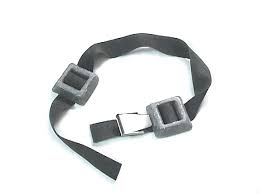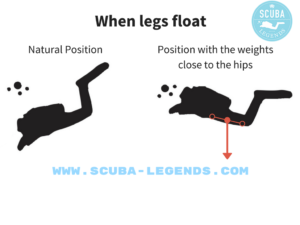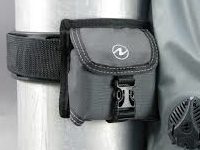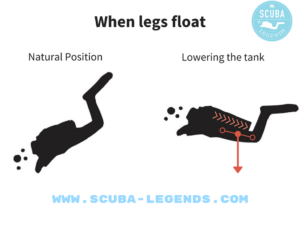With our article Introduction to trim you understood how does your trim affect both buoyancy and efficient air consumption. Now it’s time to get into it. Your trim depends basically on the weight distribution and, to a small extent, on the position of your body. You are looking for a perfect balance that allows you to remain in a horizontal position when you are not swimming.
You should start by learning what your body’s natural buoyancy is. For some people their legs sink while for others their legs float. Some people sink like a rock while others float without any effort. It is important that you know that natural buoyancy of your body, so you can apply effective changes in the distribution of your weight. At the end of the day, the more you know yourself, the better you’ll be diving.
Weight Distribution
Before we go into weight distribution, it is vital that you understand the following: It is useless to try to get a good trim if you dive overweighted. If you are not sure about it, undertake a buoyancy check before you start working on your trim.
1- Weight belt
 Usually we learn that there is only one position for the weight belt. Well tight at the waist. This is not like this. The belt can be placed either near the hips or up close to your ribs. These different positions will greatly affect your trim.
Usually we learn that there is only one position for the weight belt. Well tight at the waist. This is not like this. The belt can be placed either near the hips or up close to your ribs. These different positions will greatly affect your trim.
When your legs sink: You should place your belt near your ribs. If you place your belt at the waist the weight will cause your legs to sink even more. Conversely, lifting the weight and bringing it closer to the ribs will cause the whole chest to be pulled down. Try also to locate the weight pieces at the front, around your belly instead of the classical position with the weights at the back.
 When your legs float: This is the opposite case. You should place your belt as close as possible to your hips. Thus you can take advantage of gravity to counteract the inertia of your legs that position yourself facing down.
When your legs float: This is the opposite case. You should place your belt as close as possible to your hips. Thus you can take advantage of gravity to counteract the inertia of your legs that position yourself facing down.
2 -Weight Pockets
 When your legs sink: You should check if your BC has pockets at the back or around the tank. If you do not have pockets at the back, you can buy some and add them to the tank strip. You should see it like this: these back pockets will be the equivalent of lifting your belt towards the ribs. You must divide the weight between the back and side pockets. For safety reasons, the side pockets should be the ones carrying the greatest weight load so you can quick release it.
When your legs sink: You should check if your BC has pockets at the back or around the tank. If you do not have pockets at the back, you can buy some and add them to the tank strip. You should see it like this: these back pockets will be the equivalent of lifting your belt towards the ribs. You must divide the weight between the back and side pockets. For safety reasons, the side pockets should be the ones carrying the greatest weight load so you can quick release it.
When your legs float: In this case forget the back pockets and concentrate the weight in the side pockets. If it is not enough, consider adding a belt to your dive gear. The solution may be to divide the weight between the pockets and the belt. Some alternatives to the belt are ankle weights or heavier fins.
3 -Tank
 The tank is the heaviest part of your diving gear and therefore the most decisive part about your trim. When assembling your gear you must decide at which level you locate the tank:
The tank is the heaviest part of your diving gear and therefore the most decisive part about your trim. When assembling your gear you must decide at which level you locate the tank:
When your legs sink: Raise the tank, the valve should go closer to the nape of the neck. The upper part of our body will be dragged down by the weight of the tank. This will help to counteract that vertical position of our natural buoyancy.
 When your legs float: If we lower the tank closer to the legs we will get the opposite effect. The lower part of our body will be pulled down by the weight of the tank.
When your legs float: If we lower the tank closer to the legs we will get the opposite effect. The lower part of our body will be pulled down by the weight of the tank.
This will counteract the buoyancy of our legs.Use the weight to balance your body. Your job is to find the perfect combination for you. That weight distribution that helps you to remain horizontal without having to do any movement.
Body Position
Now that you have distributed your weight well, you only need to give a little help with your body to get the perfect trim. While the position of your body is not decisive, it is an important element in maintaining a good balance when you are diving. Somehow, what you are looking for is a position very similar to the one used for sky diving.The position when diving should be relax and comfortable. If you feel pain or your body is in tension you are doing something wrong. Relax your muscles, let go and your body will do the rest.
Somehow, what you are looking for is a position very similar to the one used for sky diving. Become broad. The broader your position, the more stable you will be.
Work on your body position:
Become broad: Separate arms and legs from your gravity centre. You might think that underwater there is no grip. But there is. Think that your whole body creates resistance to water. The broader your position, the more stable you will be. If you acquire a wide position, you will be less likely to roll sideways.
Arch your back: When you lift your hips slightly, your legs tend to ascend and the other way around. Arch a little your back without forcing, since your goal is not to injure you but to get a good trim. When arching your back you will be getting two things:
– You will raise your hips so legs will follow
– You will raise your chest a little, enough to look forward without having to resort to vertical position or injuring your cervical.
In conclusion…
By working these two factors, weight distribution and position, in a short time you will get a beautiful trim. Only by distributing your weight properly you will see the change immediately. Remember that mastery comes from experience. Good news for you, to get experienced you only need to go diving.
